Kapok, White silk cotton tree
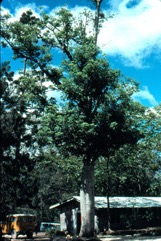
It is a tropical plant. Mostly in the lowlands and up to about 1000 m. It suits rainforest areas with a heavy rainfall. It suits humid locations. The soil needs to be well drained. It can grow in seasonally flooded forests. The tree is easily damaged by strong winds. It needs a temperature of 25°-30°C and not below 15°C. It is light demanding. It suits hardiness zones 11-12. In XTBG Yunnan.
Also known as:
Agougou, Ai-lele, Am-polon, Araba, Atagodon, Banda, Bantahi, Bantam-o, Bantan, Bantanhe, Bili buraga, Breque, Buraga, Cob-be, Elevam, Ferenji tuti, Fromager, Gbanda, Gon ta, Gunga, Hattian, Hazomorengy, Ilavu, Ilavum, Ilivam, Kabu kabes, Kabu-kabu, Kafamba, Kapoaka, Kapok-kapok, Katan, Kifampa, Kor, Kotin-tri, Koulbana, Kuci, Le-moh-pin, Lewah, M'bath, Marga, Mengkapas, Metchene, Mfuma, Msufi, Mukomu, Mullilavu, Mutunda, Myali, N'tene, Ngiu noi, Ngukho, Nguwei, Nun, Okha, Pandhari, Panji, Pentene, Pentia, Pohon kapuk randu, Poilao, Poilon, Polom, Polon-de, Poor, Psahe, Pthae, Rimi, Rumbum, Rymy, Safed simal, Salmali, Schwetsimul, Semar, Sveta salmali, Tatafu, Tella buraga, Thinbaw-letpan, Tixoxante, Untepe, Usufu, Vauvau ni vavalangi, Vavae
Synonyms
- Bombax cumanense Kunth
- Bombax guineense Schum. & Thonn.
- Bombax guineensis Schumach.
- Bobax inerme L.
- Bombax mompoxense Kunth
- Bombax orientale Spreng.
- Bombax pentandrum L.
- Bombax pentandrum Jacq.
- Ceiba anfractuosa (DC.) M. Gomez
- Ceiba caribaea (DC.) A. Chev.
- Ceiba casearia Medik.
- Ceiba guineensis (Thonn.) A. Chev.
- Ceiba occidentalis (Spreng.) Burkill
- Ceiba pentandra var. (several)
- Eriodendron anfractuosum DC.
- Eriodendron anfractuosum var. indicum DC.
- Eriodendron caribaeum G. Don
- Eriodendron guineense G. Don. & Thonn.
- Eriodendron occidentale (Spreng.) G. Don
- Eriodendron orientale Kostel
- Eriodendron pentandrum (L.) Kurz
- Gossampinus alba Buch.-Ham.
- Gossampinus rumphii Schott & Endl.
- Xylon pentandrum Kuntze
Edible Portion
- Seeds, Leaves, Calyces, Flowers, Vegetable, Fruit, Oil
Where does Kapok grow?
Found in: Africa, Andamans, Antigua and Barbuda, Asia, Australia, Barbados, Belize, Benin, Brazil, British Indian Ocean Terr., BIOT, Burkina Faso, Cambodia, Cameroon, Caribbean, Central Africa, Central African Republic, CAR, Central America, China, Colombia, Congo DR, Congo R, Costa Rica, Cuba, Dominica, Dominican Republic, East Africa, East Timor, El Salvador, Ethiopia, Fiji, Gabon, Gambia, Ghana, Guadeloupe, Guam, Guatemala, Guiana, Guianas, Guinea, Guinée, Guinea-Bissau, Guyana, Haiti, Hawaii, India, Indochina, Indonesia, Jamaica, Kenya, Laos, Madagascar, Malawi, Malaysia, Mali, Mariana Islands, Marquesas, Martinique, Mexico, Micronesia, Mozambique, Myanmar, Nauru, Nicaragua, Niger, Nigeria, North America, Pacific, Pakistan, Palau, Panama, Papua New Guinea, PNG, Peru, Philippines, Puerto Rico, Rotuma, Rwanda, Samoa, Sao Tome and Principe, SE Asia, Senegal, Sierra Leone, Singapore, Somalia, South Africa, Southern Africa, South America, Sri Lanka, St. Kitts and Nevis, St Lucia, Sudan, Suriname, Tanzania, Thailand, Timor-Leste, Togo, Tonga, Trinidad & Tobago, Uganda, United States, Venezuela, Vietnam, Wallis & Futuna, West Africa, West Indies, West Timor, Yap, Zambia, Zimbabwe
Notes: There are 4-15 Ceiba species. (The fibres of the pods are used for pillows.) The seeds contain linoleic acid. Also put in the family Bombacaceae.
Status: It is a cultivated plant.
Growing Kapok, White silk cotton tree
Cultivation: Plants can be grown from seed. Seeds germinate quickly and seedlings can be transplanted. It can be easily grown from large cuttings. Plants can be budded.
Edible Uses: The young pods can be eaten cooked. The young leaves can be eaten cooked. The seeds can be eaten either roasted fresh, or after sprouting. They are also added to soups. The young flowers can be eaten. They are blanched before eating. The resin from the trunk is put in water and drunk. CAUTION Older pods and leaves have medicinal uses. Large quantities of seeds can upset the digestion.
Production: It is a fast growing tree. Pods are produced seasonally.
Nutrition Info
per 100g edible portion| Edible Part | Energy (kcal) | Protein (g) | Iron (mg) | Vitamin A (ug) | Vitamin c (mg) | Zinc (mg) | % Water |
|---|---|---|---|---|---|---|---|
| Seeds dried | 494 | 30.9 | - | - | - | - | 6.8 |
| Leaves | - | - | - | - | - | - | |
| Flowers | - | - | - | - | - | - | |
| Fruit | - | - | - | - | - | - | |
| Sap | - | - | - | - | - | - |
Kapok, White silk cotton tree Photos

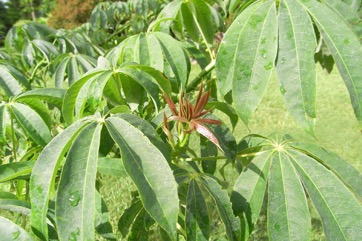
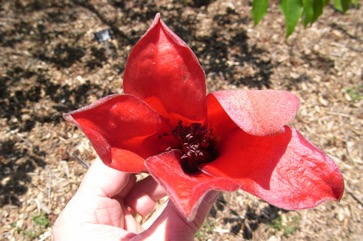
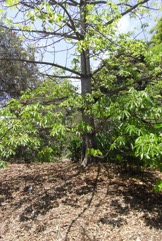
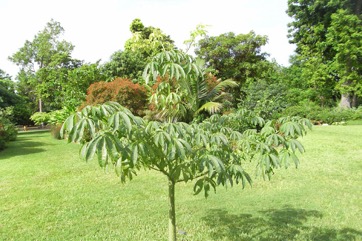
References
Abbiw, D.K., 1990, Useful Plants of Ghana. West African uses of wild and cultivated plants. Intermediate Technology Publications and the Royal Botanic Gardens, Kew. p 41
Achigan-Dako, E, et al (Eds), 2009, Catalogue of Traditional Vegetables in Benin. International Foundation for Science.
Ambasta S.P. (Ed.), 2000, The Useful Plants of India. CSIR India. p 113
Bahru, T., et al, 2013, Wild Edible Plants: Sustainable Use and Management by Indigenous Communities in and the Buffer Area of Awah National Park, Ethiopia. Ethiop. J. Sci., 36(2): 93-108
Batawila, K., et al, 2007, Diversite et gestion des legumes de cueillete au Togo. African Journal of Food, Agriculture, Nutrition and Development 7( 3& 4): 64
Barwick, M., 2004, Tropical and Subtropical Trees. A Worldwide Encyclopedic Guide. Thames and Hudson p 104
Bekele-Tesemma A., Birnie, A., & Tengnas, B., 1993, Useful Trees and Shrubs for Ethiopia. Regional Soil Conservation Unit. Technical Handbook No 5. p 144
Belem, B., et al, 2007, Use of Non Wood Forest Products by local people bordering the “Parc National Kaboré Tambi”, Burkina Faso. The Journal of Transdisciplinary Environmental Studies vol. 6, no. 1 p 9
Belem, M., et al, 2017, Strategy of Conservation and Protection of Wild Edible Plants Diversity in Burkina Faso. ANADOLU 27 (2) 2017, 82- 90
Bernholt, H. et al, 2009, Plant species richness and diversity in urban and peri-urban gardens of Niamey, Niger. Agroforestry Systems 77:159-179
Bodkin, F., 1991, Encyclopedia Botanica. Cornstalk publishing, p 231
Bonou, A., et al, 2013, Valeur economique des Produits Forestiers Non Ligneux (PFNL) au Benin. Editions Universitaires Europeennes p 98
Borrell, O.W., 1989, An Annotated Checklist of the Flora of Kairiru Island, New Guinea. Marcellin College, Victoria Australia. p 59, 179
Bremness, L., 1994, Herbs. Collins Eyewitness Handbooks. Harper Collins. p 44
Brickell, C. (Ed.), H., & Phummai, S., 2000, A Field Guide to Tropical Plants of Asia. Timber Press. p 97
Choudhary, S., 1999, Ethnobotany of Janjangbureh Island, The Gambia, West Africa. Honors thesis Dept. Biology City University of New York.
Codjia, J. T. C., et al, 2003, Diversity and local valorisation of vegetal edible products in Benin. Cahiers Agricultures 12:1-12
Condit, R., et al, 2011, Trees of Panama and Costa Rica. Princeton Field Guides. p 274
Dansi, A., et al, 2008, Traditional leafy vegetables and their use in the Benin Republic. Genet Resour Crop Evol (2008) 55:1239–1256
Djihounouck, Y., et al, 2018, Diversité Et Importance Socio-Economique Des Espèces Fruitières Sauvages Comestibles En Zone Kasa (Sud-Ouest Du Sénégal). European Scientific Journal December 2018 edition Vol.14, No.36 ISSN: 1857 – 7881
Etherington, K., & Imwold, D., (Eds), 2001, Botanica's Trees & Shrubs. The illustrated A-Z of over 8500 trees and shrubs. Random House, Australia. p 196
Facciola, S., 1998, Cornucopia 2: a Source Book of Edible Plants. Kampong Publications, p 50
FAO, 1988, Traditional Food Plants, FAO Food and Nutrition Paper 42. FAO Rome p 163
Forest Inventory and Planning Institute, 1996, Vietnam Forest Trees. Agriculture Publishing House p 77
Fowler, D. G., 2007, Zambian Plants: Their Vernacular Names and Uses. Kew. p 44
French, B.R., 1986, Food Plants of Papua New Guinea, A Compendium. Asia Pacific Science Foundation p 327
Fruct. sem. pl. 2:244. 1791 (As (L) Gaertn.)
Gallagher, D. E., 2010, Farming beyond the escarpment: Society, Environment, and Mobility in Precolonial Southeastern Burkina Faso. PhD University of Michigan.
GAMMIE, (As Eriodendron anfractuosum)
Garba, A., Useful Plants in the Chad region of North-East Nigeria. (As Eriodendron orientale)
Gardner, S., et al, 2000, A Field Guide to Forest Trees of Northern Thailand, Kobfai Publishing Project. p 77
Gilbert, T., et al, 2017, Diversity and local transformation of indigenous edible fruits in sahelian domain of Cameroon. Journal of Animal & Plant Sciences Vol. 26 (2): 5289-5300
Grandtner, M. M., 2008, World Dictionary of Trees. Wood and Forest Science Department. Laval University, Quebec, Qc Canada. (Internet database http://www.WDT.QC.ca)
Grandtner, M. M. & Chevrette, J., 2013, Dictionary of Trees, Volume 2: South America: Nomenclature, Taxonomy and Ecology. Academic Press p 116
Grubben, G. J. H. and Denton, O. A. (eds), 2004, Plant Resources of Tropical Africa 2. Vegetables. PROTA, Wageningen, Netherlands. p 560
Hahn, K., et al, 2018, The Use of Wild Plants for Food: a National Scale Analysis for Burkina Faso (West Africa) Flora et Vegetatio Sudano-Sambesica 21, 25-33
Hanawa, Y., 2013, Wild edible plants used by Guiziga people of far north region of Cameroon. Int. J. Med. Arom. Plants. Vol 3 (2) : 136-143
Hearne, D.A., & Rance, S.J., 1975, Trees for Darwin and Northern Australia. AGPS, Canberra p 43, Pl 11
http://en.hortipedia.com
Jardin, C., 1970, List of Foods Used In Africa, FAO Nutrition Information Document Series No 2.p 40, 65 (Also as Ceiba thonningii)
Keay, R.W.J., 1989, Trees of Nigeria. Clarendon Press, Oxford. p 138
Kiple, K.F. & Ornelas, K.C., (eds), 2000, The Cambridge World History of Food. CUP p 1795
Krishen P., 2006, Trees of Delhi, A Field Guide. DK Books. p 214
Latham, P., 2004, Useful Plants of Bas-Congo province. Salvation Army & DFID p 72
Liefting, A., et al, Samoan plant names. http://en.wikipedia.org
Llamas, K.A., 2003, Tropical Flowering Plants. Timber Press. p 262
Martin, F.W. & Ruberte, R.M., 1979, Edible Leaves of the Tropics. Antillian College Press, Mayaguez, Puerto Rico. p 91, 179 (Also as Ceiba guineensis and Ceiba thonningii)
Martin, M.A., 1971, Introduction L'Ethnobotanique du Cambodge. Centre National de la Recherche Scientifique. Paris.
Mbuya, L.P., Msanga, H.P., Ruffo, C.K., Birnie, A & Tengnas, B., 1994, Useful Trees and Shrubs for Tanzania. Regional Soil Conservation Unit. Technical Handbook No 6. p 174
Menninger, E.A., 1977, Edible Nuts of the World. Horticultural Books. Florida p 64
Morley, B. & Everard, B., 1970, Wild Flowers of the World. Ebury press. Plate 57
MORTIMORE,
Nkeoua, G. & Boundzanga, G. C., 1999, Donnees sur les produits forestieres non ligneux en Republique du Congo. FAO. p 22
Ochse, J.J. et al, 1931, Vegetables of the Dutch East Indies. Asher reprint. p 79
Okigbo, B.N., Vegetables in Tropical Africa, in Opena, R.T. & Kyomo, M.L., 1990, Vegetable Research and development in SADCC countries. Asian Vegetable Research and development Centre. Taiwan. p 38
Palgrave, K.C., 1996, Trees of Southern Africa. Struik Publishers. p 589
Peekel, P.G., 1984, (Translation E.E.Henty), Flora of the Bismarck Archipelago for Naturalists, Division of Botany, Lae, PNG. p 370, 368
Pham-Hoang Ho, 1999, An Illustrated Flora of Vietnam. Nha Xuat Ban Tre. p 513
Phon, P., 2000, Plants used in Cambodia. © Pauline Dy Phon, Phnom Penh, Cambodia. p 145
Plants of Haiti Smithsonian Institute http://botany.si.edu/antilles/West Indies
Purseglove, J.W., 1968, Tropical Crops Dicotyledons, Longmans. p 34
Raponda-Walker, A & Sillans, R., 1961, Les Plantes Utiles du Gabon. Editions Paul Lechevalier, Paris. p 106
Sahni, K.C., 2000, The Book of Indian Trees. Bombay Natural History Society. Oxford. p 40
Savill, P. S. & Fox, J. E. D., Trees of Sierra Leone. p 56
Segnon, A. C. & Achigan-Dako, E. G., 2014, Comparative analysis of diversity and utilization of edible plants in arid and semi-arid areas in Benin. Journal of Ethnobiology and Ethnomedicine 2014, 10:80
Segura, S., et al, 2018, The edible fruit species in Mexico. Genet Resour Crop Evol (2018) 65:1767–1793
SHORTT, (As Eriodendron anfractuosum)
Smith, A.C., 1981, Flora Vitiensis Nova, Lawaii, Kuai, Hawaii, Volume 2 p 413
Staples, G.W. and Herbst, D.R., 2005, A tropical Garden Flora. Bishop Museum Press, Honolulu, Hawaii. p 194
Sukarya, D. G., (Ed.) 2013, 3,500 Plant Species of the Botanic Gardens of Indonesia. LIPI p 188
Tang Ya, BOMBACACEAE [Draft], Flora of China
Timyan, J., 1996, Bwa Yo: Important Trees of Haiti. SE Consortium for International Development. Washington. p 211
Topp, J. M. W., 1988, An Annotated Check List of the Flora of Diego Garcia, British Ocean Territory. Atoll Research Bulletin No. 313
Turreira Garcia, N., et al, 2017, Ethnobotanical knowledgeof the Kuy and Khmer people in Prey Lang, Cambodia. Cambodian Journal of Natural History 2017 (1): 76-101
Vickery, M.L. and Vickery, B., 1979, Plant Products of Tropical Africa, Macmillan. p 73
WATT, (As Eriodendron anfractuosum)
Wickens, G.E., 1995, Edible Nuts. FAO Non-wood forest products. FAO, Rome. p 110
Williams, C.N., Chew, W.Y., and Rajartnam, J.A., 1989, Tree and Field Crops of the Wetter Regions of the Tropics. Longman, p 84
Williamson, J., 2005, Useful Plants of Malawi. 3rd. Edition. Mdadzi Book Trust. p 59
Young, J., (Ed.), 2001, Botanica's Pocket Trees and Shrubs. Random House. p 218
Yuncker, T.G., 1959, Plants of Tonga, Bernice P. Bishop Museum, Hawaii, Bulletin 220. p 185
Zeven, A.C., 1979, Kapok, in Simmonds N.W.,(ed), Crop Plant Evolution. Longmans. London. p13
Zuchowski W., 2007, Tropical Plants of Costa Rica. A Zona Tropical Publication, Comstock Publishing. p 41, Flora of China
Vickery, M.L. and Vickery, B., 1979, Plant Products of Tropical Africa, Macmillan. p 73
WATT, (As Eriodendron anfractuosum)
Wickens, G.E., 1995, Edible Nuts. FAO Non-wood forest products. FAO, Rome. p 110
Williams, C.N., Chew, W.Y., and Rajartnam, J.A., 1989, Tree and Field Crops of the Wetter Regions of the Tropics. Longman, p 84
Williamson, J., 2005, Useful Plants of Malawi. 3rd. Edition. Mdadzi Book Trust. p 59
World Checklist of Useful Plant Species 2020. Royal Botanic Gardens, Kew
Young, J., (Ed.), 2001, Botanica's Pocket Trees and Shrubs. Random House. p 218
Yuncker, T.G., 1959, Plants of Tonga, Bernice P. Bishop Museum, Hawaii, Bulletin 220. p 185
Zeven, A.C., 1979, Kapok, in Simmonds N.W.,(ed), Crop Plant Evolution. Longmans. London. p13
Zuchowski W., 2007, Tropical Plants of Costa Rica. A Zona Tropical Publication, Comstock Publishing. p 41